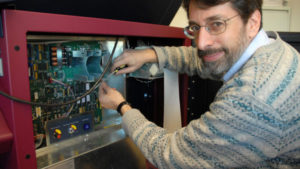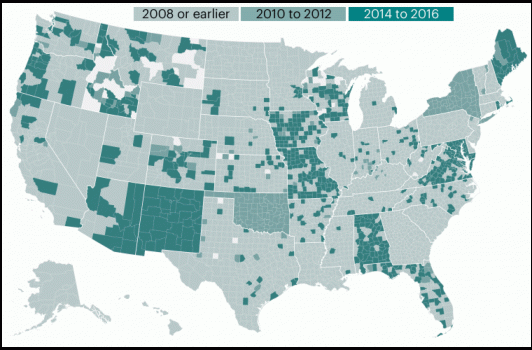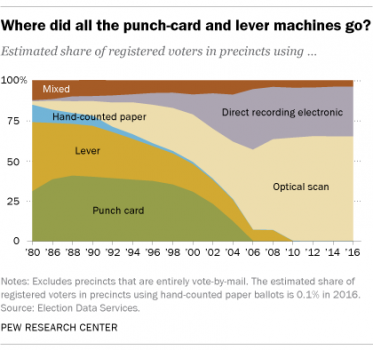Epic Voter Fraud Predicted for US 3rd World Presidential Election in 2020
Mon 12:45 pm +01:00, 9 Nov 2020
Editor Note: This is a repost of our now timely post from October, 2019 when we predicted massive electoral fraud. Now we learn that Dominion vote software has a vote switching “problem”. This has been seen in Antrim County, Michigan. Crime Syndicate operatives are blaming the snafu on “clerical error”, but the fact is that it is the software company company’s responsibility to update.
This software is used in thirty states and in every battleground state. This will be a focus of any investigation into rigged elections.
Former federal prosecutor Sidney Powell accused Nadeam Elshami, House Speaker Nancy Pelosi’s former chief of staff who last year became a lobbyist for Dominion, and Richard Blum, California Sen. Dianne Feinstein’s husband, who she said is a significant shareholder in the company.
“They have invested in it for their own reasons and are using it to commit this fraud to steal votes.
Next we will see the bogus, false Hanlon’s Razor applied by the Crime Syndicate as an excuse. Then the incompetents will be promoted. As a reminder this razor is often used to decoy away from criminal activity and malice for the consumption of the pajama people.

Stalin dictum on voting is in play: “It does not matter how they vote, what matters is who is counting the votes.”
Here’s the neoliberal version: “It does not matter how they vote. If elections are close, all that matters is who is performing exit polls and cries louder about irregularities in the elections to the media.”
The 2020 election will be a shitstorm of voter fraud and irregularities, and thus controversy.
Research at Argonne National Laboratories revealed that a single individual with physical access to a voting machine, can install inexpensive, readily-available electronic components to manipulate its functions.
Winter Watch predicts the 2020 presidential election will make the 2000 chads debacle look like a piker — and it will be deliberately and malevolently arranged that way. It is likely to be manufactured to be close. The perfect storm. Election technology will be full-court third world.
Propublica: In a recent nationwide survey by the Brennan Center for Justice, election officials in 33 states reported needing to replace their voting equipment by 2020. Officials complain the machines are difficult to maintain and susceptible to crashes and failure …
The Brennan Center estimated that 43 states, along with the District of Columbia, used polling place machines that were no longer manufactured. Wendy Underhill, director of elections and redistricting at the National Conference of State Legislatures says “Some voting equipment today works with old operating systems — Windows XP or Windows 2000 — and data storage devices we wouldn’t even know what to do with today.” …
To find parts for Minnesota’s outdated voting equipment, Deborah Erickson, director of administrative services for Crow Wing County, told a Minnesota House committee, “The best answer to that is eBay.” …
During the 2016 presidential election, aging machines contributed to scattered reports of “vote flipping” in Georgia, Nevada, North Carolina, Pennsylvania, Tennessee and Texas. Flipped votes occur when a voter selects one candidate but the voting machine shows a different selection. …
“Today’s voting systems are not going to last 70 years, they’re going to last 10,” says U.S. Elections Assistance Commission Commissioner Matt Masterson. While previous generations of voting equipment, lever machines and punch cards, had hardware that could be relied on for decades, today’s technology becomes outdated a lot faster. …
“Election officials are low on the totem pole, budget-wise,” says Masterson. …
A 2014 report by the Presidential Commission on Election Administration reported that election administrators viewed themselves as the “least powerful lobby in state legislatures and often the last constituency to receive scarce funds at the local level.” …
In the past four years, only two states have provided sufficient funds, to completely replace old voting equipment.
Unfortunately. several of the key swing states are using third-world voting technology. You can see them in the chart below. They include Pennsylvania, Ohio, Michigan, Georgia, New Hampshire, Nevada, Minnesota, North Carolina and the high population counties of Florida that were problematic in 2000.
There’s no shortage of demonstrations of small-scale in-person hacks in particular.
Trump won Michigan by less than 11,000 votes and Wisconsin by less than 23,000 in 2016. He was roundly beaten in the national popular vote by 2.87 million ballots.
Biden’s margin in Pennsylvania is 46,000 votes, Wisconsin 20,500, Georgia 10,000, Arizona 17,000, Nevada 34,000.

Other examples of election skulduggery on antiquated machines includes:
- Tampering with the software of a voting machine to add malicious code that alters vote totals or favors a candidate in any way.
- Multiple groups have demonstrated this possibility.
- Private companies manufacture these machines. Many companies will not allow public access or review of the machines’ source code, claiming fear of exposing trade secrets.
Virtually all the machines used now are these antiquated, electronic, direct recording electronic (DRE) and optical scanners.

Election Systems & Software, based in Omaha, Nebraska, is the giant of the voting machine industry. ES&S claims a U.S. market share of more than 60 percent in customer voting system installations.
In a February 2018 article in The New York Times, writer Kim Zetter reported that remote-access software had been found on an election management computer system used in Pennsylvania.
Zetter quoted unnamed sources, one of whom said, “ES&S has in the past sometimes sold its election-management system with remote-access software pre-installed.”
This remote access software was used by ES&S technicians to remotely troubleshoot system issues and provide maintenance to systems the company sold. ES&S insisted they were innocent.
“None of the employees… including long-tenured employees, has any knowledge that our voting systems have ever been sold with remote-access software.”[37]
But after Congress looked into it, ES&S changed their tune and sent a letter sent to Oregon Sen. Ron Wyden (D) in April 2018 in which it disclosed that “some” election management systems that the company sold to voting districts did in fact have remote-access software installed. This disclosure was made public in July 2018.
By installing remote access software and allowing voting machines to be accessed via the internet, the machines were/are vulnerable to being “hacked” remotely. It allows voting tallies to be altered surreptitiously, or malware to be installed to affect an election result.
Motherboard, which originally published the story, called the remote access software installation “the worst decision for security short of leaving ballot boxes on a Moscow street corner.”
Where votes are recorded through electronic or mechanical means, the voting machinery may be altered so that a vote intended for one candidate is recorded for another.
In these antiquated machines the votes are logged directly into a computer’s memory banks – but the system would not generate any “paper trail” for future recounts.
According to Verified Voting, of the 53,608 jurisdictions that use DRE equipment as their major voting method, almost three-quarters use systems that don’t create paper receipts or other hard-copy records of voters’ choices.
Thus, it’s not only possible but probable — especially in a kakistocracy like the U.S. — that authorities artificially control the composition of an electorate in order to produce a foregone result.
Additionally, with millions of uncounted illegals in the country, one way of loading elections is to bus a large number of voters into the electorate prior to an election, for example, by temporarily assigning them land or lodging them in flophouses.
Another strategy is to permanently move people into an electoral district, usually through subsidized public housing. If people eligible for public housing are likely to vote for a particular party, then they can either be concentrated into one area, thus making their votes count for less, or moved into contested states, where they may tip the balance toward a specific party.
Winter Watch would add that the use of cutouts and fake personas (often the deceased) such as demonstrated in the staged deceptions is a very underestimated phenomenon as well.
Epic Voter Fraud Predicted for US 3rd World Presidential Election in 2020


